Dogs may become fearful or have a strong emotional reaction to loud noises such as thunderstorms, fireworks, or garbage trucks. Some dogs fear being alone, while others become reactive when confined.
Different dogs have different temperaments and will react differently to various stimuli. Shy dogs may escape or run away at the first sign of trouble, while more confident dogs may decide to stay and fight. A naturally confident dog will recover from new and fearful experiences much faster than a naturally shy dog.
Young dogs tend to be more open to new experiences, and bounce back more quickly. This is why we want to socialize our dogs to many positive new experiences when they are young, so that they will grow up to be a confident and balanced adult dog.
However, we can train any dog to better handle stress or fear, and become more confident. All it takes is time, patience, and a lot of repetition. One of the best ways to calm a fearful or reactive dog is through the desensitization process.

Dog Desensitization – A Good Way to Calm a Dog
The desensitization process works by initially exposing a dog to very low levels of the problem stimulus. Once the dog becomes accustomed to the low level stimulus, we very slowly increase its intensity. Over time, our dog will learn to tolerate and be calm at even higher levels of the reactive stimulus.
Patience is key because we do not want to raise the stimulus potency too quickly and cause our dogs to lose control. Frequent loss of control (from fear or over-excitement) will not only set back our desensitization work, but also make our dog mistrust us, and become even more reactive.
Dog desensitization exercises are commonly combined with counter-conditioning techniques.

In addition to getting our dog calm and comfortable with the problem stimulus (desensitization), we also help him re-associate a previously negative stimulus with something positive (counter-conditioning).
Counter conditioning is achieved by engaging our dog in focus/eye-contact training and other simple dog obedience commands (e.g. Sit) during the desensitization process. When our dog stays calm and follows our commands we reward him well with affection and his favorite treats. In this way our dog learns to re-associate the ‘bad’ stimulus with calmness, yummy treats, and affection from us.
Note – We only reward good behaviors, i.e. our dog following commands and staying calm. Do not give treats or affection to your dog when he loses control, or when he is showing fear symptoms. If you do this with the wrong energy or technique, it will only encourage his reactivity and fears. Instead, just remove him to a quiet area where he can calm down on his own.
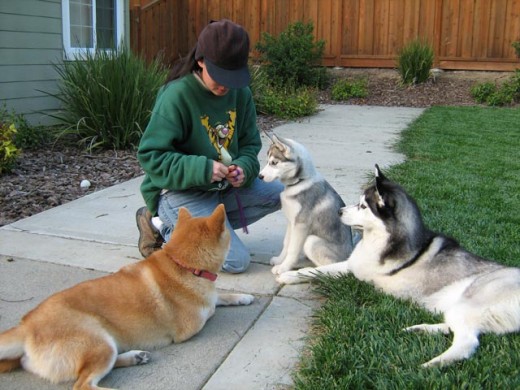
Calm a Dog to Noise

For a dog that is fearful or over-excited of loud noises such as fireworks or thunderstorms, the trigger stimulus is the noise. Therefore, our noise desensitization session would go something like this –
- We get a recording of fireworks or a thunderstorm and then play it (in loop mode) on our stereo at a very low volume. Make sure that the initial volume is low enough that our dog is able to stay calm.
- We engage our dog in focus and obedience exercises while the recording is playing and reward him well for staying calm and following commands.
- If everything is well, we increase the volume of our recording slightly and repeat step 2.
- If our dog stops accepting treats, or is no longer able to focus then we have moved forward too quickly. At this point we want to lower our volume by a few notches. Once our dog is calm again, we can repeat step 2.
- It is important to keep desensitization sessions short, positive, and rewarding. In this way, our dog will start to associate fireworks and thunderstorms with positive experiences rather than something that is threatening and stressful.
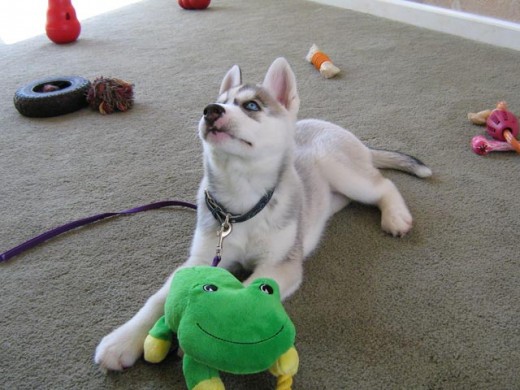
Calm a Dog to People

Dogs may also become anxious or over-excited when people come into their space and pet or hug them. Dogs are not humans, and they do not have the same communication cues as we do. When meeting a new dog, especially a shy dog, it is best to first ignore the dog and let him approach us.
We can help our dog become less fearful of people by desensitizing him using distance, focus, and rewards –
- Ask a friend to sit under a tree in our backyard and read a book.
- Meanwhile, we have our dog on-leash and stand far enough away from our friend that our dog is calm and relaxed.
- We get our dog’s focus and do some simple obedience exercises. He gets rewarded for staying calm and working together with us.
- If all is well, we move one step toward our friend and repeat step 3.
- It is important that our friend totally ignores the dog, which means no talking and no eye-contact. Eye-contact can be seen as an invitation to interact, or as a threat, especially by a shy dog. Either way, it can trigger an excited or fearful response.

As always, we want to keep desensitization sessions short, fun, and rewarding. In this way, our dog will learn to re-associate people with calmness and positive experiences.
- After several sessions, we may get close enough to our friend that she can throw some high priority treats to our dog. However, it is still important not to initiate eye-contact.
- If our dog is calm and does not have a bite history, we can let him come over and sniff our friend (still no eye-contact).
- Once our dog is comfortable with the scent of our friend and is calm, then we can bring her back a few paces and repeat the desensitization exercise with brief periods of eye contact.

In later stages we can repeat the desensitization process for –
- A person who is moving slowly.
- A person wearing unusually clothing, big hats, or carrying an umbrella.
- A person on a skateboard or bicycle.
- A person who is talking softly.
- A person who is talking in a high-pitched tone.
- A threatening person who is talking loudly.
The more things we desensitize our dog to, the more confident he will become and the more prepared he will be to handle new experiences.
However, patience is extremely important. The key to the desensitization process is to help dogs re-associate previously stressful or highly emotional situations with something calm and positive. Going too fast can scare our dog and cause him to become even more reactive of people.
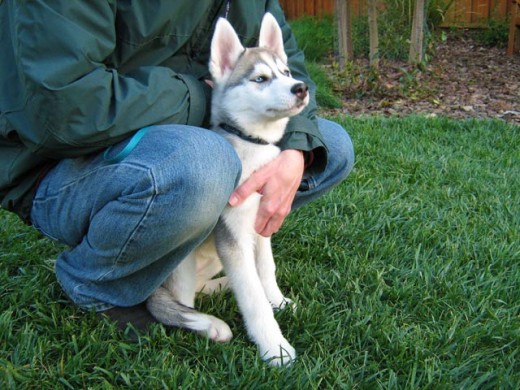
Calm a Dog to Confinement

Some dogs may get reactive when they are first confined in a crate. Confinement can be stressful because the dog loses his ability to escape if a threat should arise.
Before confining a dog in a crate for any length of time, it is best to first get the dog calm and desensitized to the crate.
- We start by showing the crate to our dog and letting him smell and examine it.
- Next we put some food near the entrance of the crate and let our dog step in to eat it.
- When he is comfortable with that, we throw some food deeper into the crate.
- We continue until our dog is cheerfully going into the crate on his own. At this point, make sure to leave the crate door open so our dog can move into and out of the crate freely.
- Once our dog is calmly moving into and out of the crate, we can close the door briefly. Wait one second, and then open the door again.
Finally, we slowly lengthen the time that our dog spends in the crate.
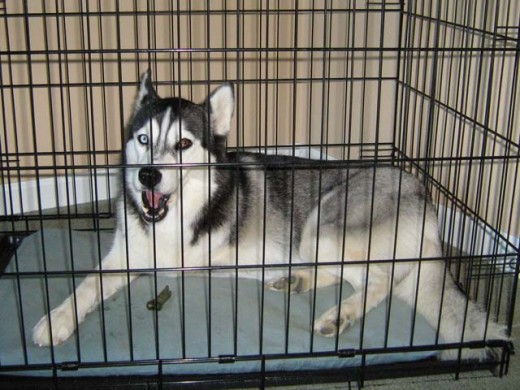
Desensitization vs. Flooding
In addition to desensitization, there is another technique called flooding that can also be used to deal with dog anxieties and fears.
With desensitization we expose a dog slowly to low amounts of the fear stimulus. We get the dog comfortable with the low level stimulus, then gradually train him to accept greater levels.
Flooding, on the other hand, exposes a dog to large amounts of the fear stimulus right away. The dog is then forced to experience the fear stimulus until he calms down.
Like us, a dog’s body can only keep pumping adrenalin for a fixed amount of time, i.e. there is a time limit to a dog’s fear response or panic attack. Theoretically, both human and dog will calm down after some time, realize that there is nothing to fear, and start to associate that new feeling of ease with the previously fearful stimulus.
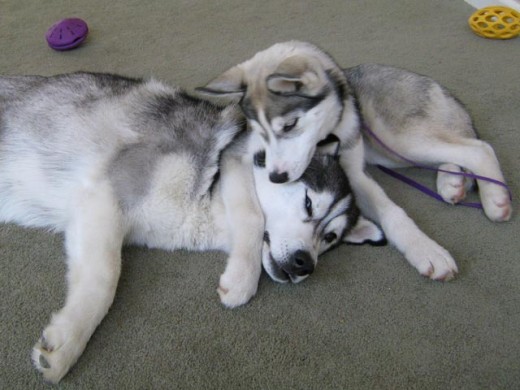
Flooding may be faster than the desensitization process, but it is risky, more traumatic, and may cause the dog to just shut down and stop responding.
Flooding is a psychotherapeutic method for overcoming phobias. This is a faster, yet less efficient and more traumatic, method of ridding fears when compared with systematic desensitization.
~~[Wikipedia]
For this reason, most animal behaviorists recommend using desensitization and counter conditioning methods to treat dog anxieties and fears. Desensitization may take more patience and more time, but it is safer, the results are long-lasting, and it helps to build a strong bond between us and our dog that is based on trust and respect.
The key to everything is patience. You get the chicken by hatching the egg, not by smashing it.
~~[Arnold H. Glasgow]

My dag is scared to bits of bicycles. This fear has come out of nowhere. I am trying to alter his reaction to bikes at the moment and gathering as much info as possible.
Clicker training with rewards seems to be helping but a long way to go yet.
I have a 5 yr old Shihzu and is constantly looking to the front door like someone is going to come in and do him harm. Spends most of his time under the bed or behind the couch. Marks his territory every where. He whines at me to be at the TV and when I do, he goes behind the couch. I have a doggie door, but he wants me to stand by the door while doing his duty if I walk away , he rushes in through the doggie door, or if there is a loud noise he runs in the doggie door.
Would appreciate suggestions.
Thank You
Good points, except the bit about having a friend sitting under a tree – to my dog that would set her off because the person would look like he is “hiding”. Anyone who has their body partly obscured by an object or is in a shaded or darkened spot appears to be hiding or being sneaky to her and it makes her fearful and aggressive. If someone peeps out of a doorway or appears from around a car it makes her freak out. I would have to have the person out in the open clearly visible to try this 🙂
hi there! I have a one year old aussie and she has been trained to some degree, is very good around my friends and family, sleeps on a bed in my room at night ect. she is however an outside dog, and is most of the time, outside with my three other dogs, she is the only one allowed inside. she does okay on our jogs, she doesn’t bark at dogs that are behind fences, or people doing yard work (too much) unless I get tense, but she really has issues when we are running and there are other dogs or people on the street. she barks and backs away, not sure if that means that she’s afraid or if she’s just being aggressive from a distance? either way I’ve had her since the day she was born in a litter of puppies that we had as rookie breeders, she has become very bonded to me and only me. That’s probably a bad thing. recently we had company in town and they brought their 4 month old puppy, this was the first time I had ever seen her be truly aggressive. It honestly made me really sad seeing her behave the way she did. she played nice with her when we were all outside but as soon as we brought her inside with the pup, (both of them were on leashes) the puppy just wanted to play and my dog who was standing next to me started stepping back and growling, I corrected her with her training collar but she kept repeating the behavior, I really want her to be a dog that I can take everywhere with me, and that will behave when I do. PLEASE HELP ME!!!!
Hello. I have been searching for a good solution to end some problem behaviors in my dog. He is a 9 or so year old rescued Australian Cattle Dog. His name is Ben and he is mostly the sweetest lovable dog. We have adopted him when he was about 1 or 2 years old from a ACD rescue. It may have to do with his breed but he has a high prey drive, high level of herding instinct. He is also to excitable to loud noises and groups of people or sometimes a loud person. His reaction is sometimes stalled and sometimes imediate. He hears a loud noise and he will nip or (heel) people near him. I am guessing he is startled? He responds the same way to loud people and has nipped several people at our house while we are visiting in a group. Never actually biting or causing cuts or brusies. But obviously this is not acceptable behavior. Should I work with him on exposure? Thank you! Holly